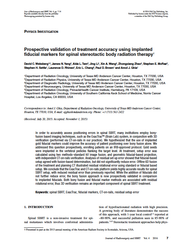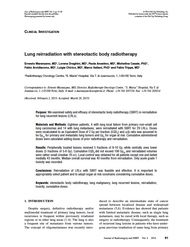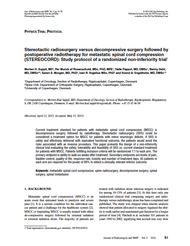- Home
- Journal Contents Downloads
- JRSBRT Downloads
- JRSBRT 4.1, p. 53-60
Product Description
Predicting treatment related imaging changes (TRICs) after radiosurgery for brain metastases using treatment dose and conformality metrics
B. Frazier Taylor, Jonathan P. Knisely, Jack M. Qian, James B. Yu and Veronica L. Chiang
Purpose: Treatment-related imaging changes (TRICs) after stereotactic radiosurgery (SRS) involves the benign transient enlargement of radiographic lesions after treatment. Identifying the radiation dose volumes and conformality metrics associated with TRICs for different post-treatment periods would be helpful and improve clinical decision making.
Methods: 367 metastases in 113 patients were treated using Gamma Knife SRS between 1/1/2007-12/31/2009. Each metastasis was measured at each imaging follow-up to detect TRICs (defined as ≥ 20% increase in volume). Fluctuations in small volume lesions (less than 108 mm3) were ignored given widely variable conformity indices (CI) for small volumes. The Karolinska Adverse Radiation Effect (KARE) factor, Paddick’s CI, Shaw’s CI, tumor volume (TV), 10 Gy (V10) and 12 Gy (V12) volumes, and prescription isodose volume (PIV) were calculated.
Results: From 0-6 months, all measures correlated with the incidence of TRICs (p<.001), except KARE, which was inversely correlated. During the 6-12 month period all measures except KARE were still correlated. Beyond 12 months, no correlation was found between any of the measures and the development of TRICs.
Conclusions: All metrics except KARE were associated with TRICs from 0-12 months only. Additional patient and treatment factors may become dominant at greater times after SRS.
Keywords: radiosurgery, SRS, conformality metrics, TRICs, KARE, brain metastases
 Loading... Please wait...
Loading... Please wait...








